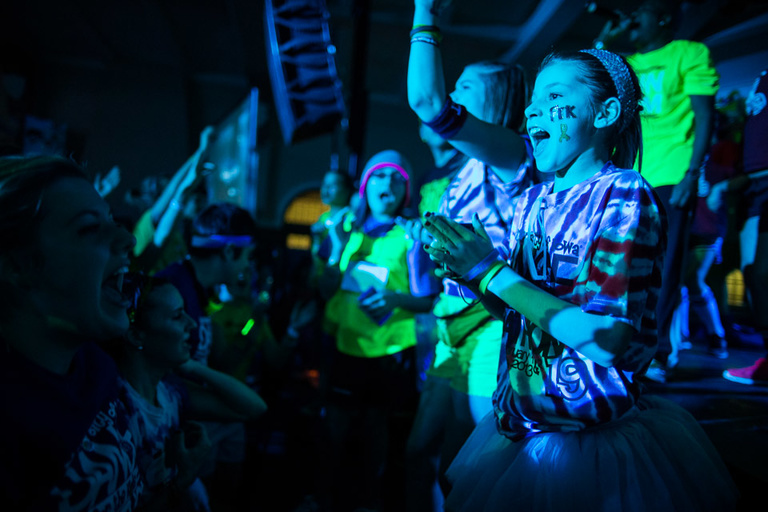It was a February evening in 1998 when Emily Mozena laced up her dancing shoes and embarked on a journey that would leave her forever changed.
The then-19-year-old Iowa City native had signed on to participate in Dance Marathon, the University of Iowa’s largest student run philanthropy featuring year-round patient centered activities and the “Big Event," a full day dance extravaganza to benefit pediatric cancer patients and their families.
The 20th Dance Marathon at the University of Iowa kicks off Friday, Feb. 7. Learn more here.
She wasn’t sure what to expect, or even how she would manage 30 hours on her feet. But as she swayed to music at the Iowa Memorial Union (IMU) ballroom, Mozena sensed there was no turning back.
“I was hooked,” she says. Indeed, since that first groove around the IMU floor, Mozena hasn’t missed a marathon. At every closing ceremony, she is there, watching with pride as the cancer patients she once represented grow into adulthood, and with tears as those who could not are remembered.
“It’s an emotional rollercoaster,” says Mozena, now a UI Health and Human Physiology lecturer and child life specialist. “I love Dance Marathon for the smiles and the energy it brings, but there are always tears in my eyes for the kids who have passed away.”
Above her desk, Mozena keeps a number of buttons memorializing Dance Marathon’s smallest participants, each year the font growing progressively tinier as more are added to the list.

Looking back, moving ahead
But as the number of participating patients and survivors has grown, so too has Dance Marathon. Now in its 20th year, the UI philanthropy has raised more than $12.7 million—$1 million of which was used to establish a renovated pediatric cancer and blood disorder research laboratory—and the Big Event has swelled to become the second largest in the nation.
Today it seems a far cry from its humble beginnings in 1994, when dean of students David Grady remembers only a hundred or so people trickling into the IMU ballroom. That year participants danced for a staggering 36 hours, sans caffeine and watches to track the time.
Thankfully for tired feet, the event was gradually scaled back to 24 hours several years ago, and students can spend time chatting with patients and families or munching on snacks provided by donors and prepared by IMU Catering.
The UI Dance Marathon will be broadcast live on UITV (Mediacom 17 in the Iowa City/Cedar Rapids area) and live streamed to the Dance Marathon website at dancemarathon.uiowa.edu/stream.
But whatever the nature of the Big Event, it’s what transpires off the dance floor that counts, says Grady. “Dance Marathon has a lasting impact on the students. It complements what they are doing in the classroom, and gives them an opportunity to apply what they’ve learned,” he says.
Finding a calling
Take alumna Elsye Meardon of Fort Madison, for example. After being persuaded by a roommate to join the cause in 2009, Meardon danced the night away and has yet to look back.
“I was learning life skills like conflict-resolution and management by doing, not by reading or writing papers. That taught me I could make an impact with whatever career I chose,” she says.
For Meardon, that career was closer to home than she realized. Just one short year after graduation, she accepted a position with Children’s Miracle Network Hospitals as a national Dance Marathon manager, where she coordinates resources and support for Big Events across the nation.
“I’ve seen my experience come full circle, from being a dancer and part of a leadership team to my current position,” she says. But like other philanthropy alumni, Meardon credits the bonds she formed with patients and fellow students as the true reason behind her long relationship with the program.
Staying connected
“I met people who were really caring and passionate and wanted to make a difference in the world,” says cancer survivor and Dance Marathon alumna Kristi Musser of Riverside. “I knew I always wanted to be a part of that.”
Musser, who currently works as a pediatric audiologist in Minneapolis, has maintained a relationship with the philanthropy through the Dance Marathon Alumni Group, a special division of the UI Alumni Association that coordinates news and events to reach former dancers across the nation.
The group has kept her connected during several relocations, and Musser describes at least one fellow alumni encounter as a meeting of “kindred spirits.” But perhaps most importantly, she notes that graduates of Dance Marathon maintain the same drive and goals they had during her dancing days.
Meardon would likely agree. “The students coordinating UI Dance Marathon today are the future leaders and CEOs of our nation,” she says.